Last Updated on June 26, 2023
Do you want to fit a car lift into your garage but aren’t sure if it’ll fit? But installing a car lift isn’t as simple as just buying one. You have to consider many things, like the size of the car lift, the type of flooring needed, safety measurements, and more.
Generally, if you have a 7′ garage and 35″ tires on the truck, it will fit with just an inch or two of clearance. If your lift is bigger and has larger tires, you may need to modify your garage to make it fit.
But before you make the purchase, you’ll want to ensure that your garage is properly suited for a car lift. You also need to know how much room you need for a car lift in the garage, how far it should be from the wall, and so on.
Let’s explore all the information you need about the size and safety of car lifts.
Will a Car Lift Fit in My Garage: Maximize Your Garage Space
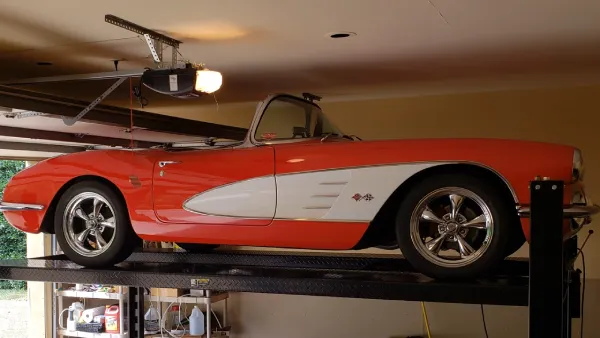
When it comes to maximizing your garage space, a car lift is a great option. This allows you to free up valuable real estate in the rest of your garage that can be used for other projects or activities, such as woodworking or other hobbies.
But the real concern is if the car lifts you have will fit in your garage. If you’re thinking about putting one in your space, keep these things in mind:
Garage Size: The car lift size must be appropriate for the size of your garage. A more significant lift will need a wider garage area than a smaller one, so measure your garage before ordering or buying it.
Ceiling Height: Ensure you have enough ceiling height to fit the lift and its components. Most lifts require at least 11-12 feet of overhead clearance to accommodate the full extension of arms, so this should be considered carefully when making calculations.
Garage Door Size: Measure the garage door opener, so you know how it fits. Here, it’s important that you pay attention to both width and height when taking measurements.
Make sure you measure at both the widest and tallest points, as your opening may not be perfectly square-shaped.
Again, record these measurements in an organized fashion so they can easily be referenced later on if needed. We suggest writing them down on paper or typing them into a digital spreadsheet for safekeeping.
Measure the Lifted Truck’s Length: Start by measuring from the front bumper to the rear bumper, following the longest part of the truck.
Take into account any accessories that may be mounted on the sides, like a bull bar or running boards, as this will affect the overall length of your truck.
Be sure to measure in straight lines and not along curves or arches. You should also measure at least twice to ensure accuracy and take note of any measurements you make.
Measure the Width: To accurately measure the width of your lifted truck, start by measuring from one side mirror to another.
Include any accessories mounted on either side of the vehicle in this measurement, as this could affect whether or not it fits inside your garage.
Double-check your measurements to make sure they’re accurate, and measure straight lines, not curves.
Measure the Height: This is the most important when determining if your lifted truck will fit inside your standard garage, as it must clear any door frames on entry and exit.
Start by measuring from ground level up to the highest point of your truck. Including any roof-mounted accessories like antennas or airbags which may add extra height to your vehicle.
Again, double-check all measurements and take notes for accuracy and convenience later down the line when checking compatibility with various garages.
Calculate and Compare Measurements:
Once you have measured the height, width, and length of both your standard garage door frame and lifted truck, it is time to compare these measurements and see if they are compatible with one another.
Calculate how much space there is between each measurement (height, width, length). Then subtract these figures from one another so that you can determine how much space remains between them.
This will let you know if there is enough room for maneuverability when entering/exiting a particular garage size style with ease.
Always keep in mind areas such as driveways & pathways where possible obstacles may lie, which could prevent successful entry/exit even if a particular measurement fits within its respective garage frame size. Always leave enough wiggle room, just in case.
Floor Strength: Another important factor must be considered when finding the best place for a car lift within your garage. Generally, most cars don’t weigh more than 2500 pounds fully loaded.
But depending on what kind of vehicle you plan to use with the car lift, additional weight may also need to be accounted for. Therefore, ensure your concrete floor can withstand enough weight without cracking or caving in.
Power Source: The power source is essential when adding a car parking lift in your garage since it often requires an external power source to operate effectively. A professional electrician can install wiring correctly to provide safe and reliable power for your project.
Garage Ventilation: Lastly, ventilation is essential when using tools like air compressors and grinders with the car lift. Aside from providing fresh air while working on vehicles (especially if chemicals like brake fluid are used), these fumes can become hazardous if left unchecked over time.
With a two-post or four-post style lift lock, you can store both cars in one area while taking up less floor space than needed by two separate parking spots.
How Much Space Do I Need for a Car Lift in a Garage?
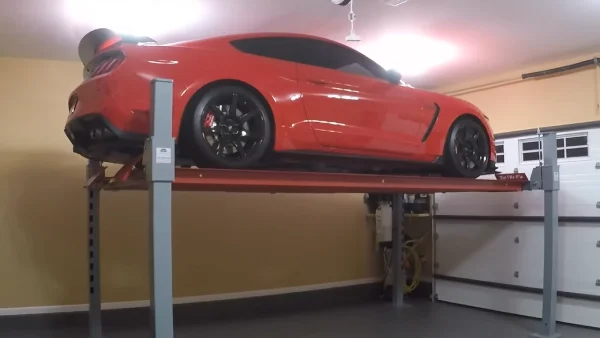
The amount of space you’ll need depends on the type of lift you choose, but generally speaking, you should plan for 12 feet minimum.
For a two-post lift, you’ll need to go down at least 2 feet and have the pads be 12″ wider on each side from the base plates of the lift. If you’re installing a four-post lift, the car needs between 30-40 inches from the garage floor to the lift base. This creates enough space and ground clearance allowing you to slide underneath easily.
The good news is that there’s no golden rule for where auto lifts should go. However, it’s generally recommended that you create at least two feet of clearance on either side of your vehicle when using a two-post lift and five to six feet for vehicle height on four-post lifts.
Overall, if you want to install a typical 2-post or 4-post lift in your garage, ensure your ceiling is above 11 feet and leave at least 12 feet of clearance for optimal use. Considering these steps before buying and installing an auto lift in your garage can help ensure it’s safe and effective.
How Big Should a Garage With a Car Lift be?
The size of your garage largely depends on what kind of lift you get and other activities you plan to do in the space. Generally, you’ll need at least 12 feet of clearance for a two-post lift and around 30-40 inches of ground clearance when using a four-post lift.
It’s also important to consider additional tools or equipment that may accompany a car lift, such as an air compressor or other tools. Depending on these factors, it’s recommended to have between two feet and 5-6 feet for a vehicle’s height for most lifts. Your ceiling must be higher than 11 feet for optimal use.
What Do You Do If Your Lifted Truck Won’t Fit In Your Garage?
If you’ve followed all the steps above but find that you can’t fit your lifted truck in your garage, don’t despair. Below are some solutions available that may help you successfully store your vehicle indoors.
1. Modify Your Garage
If your truck is too tall to fit in your garage, you may need to make modifications. This could include removing any items that are currently stored in the garage or even raising the roof of the garage.
It’s better to hire a pro if you want to raise the roof safely and correctly. You should also consider any changes in ventilation and moisture levels as well as changes in lighting when making these modifications.
If your garage has an attic or loft space above it, you may need to consider whether or not any of those items need to be relocated for your truck to fit in the modified space.
2. Lower the Truck
Lowering the suspension on your truck may be another option if it’s too tall for your garage. While this can be beneficial for fitting into tighter spaces, it’s important to keep in mind that this can affect both the performance and handling of your vehicle.
If you go this route, be sure you know exactly how much you’ll have to lower the suspension and how this will affect its performance and safety.
Make sure you take off any aftermarket lift kits before lowering your truck because they can cause complications later on.
3. Remove Auxiliary Lights
In case none of these modifications work, you may want to try removing any auxiliary lights that are mounted to your truck’s body or frame.
Some trucks come with a variety of extra lighting features, such as fog lights and spotlights. If so, these can be removed without affecting their performance too much.
Depending on the model of truck you own, some wires might have to be cut and spliced back together afterward. This must be done by a professional who knows what they’re doing. So take extra precautions when doing so.
Where Should a Car Lift be Placed in a Garage?
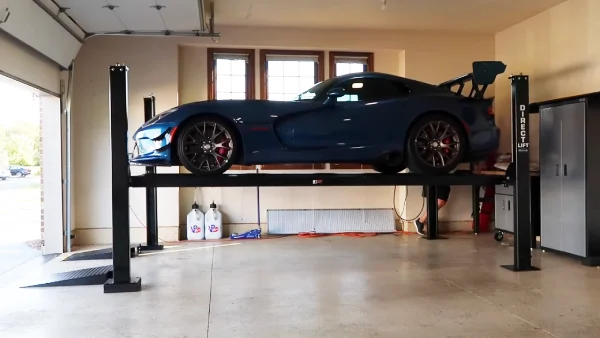
The most appropriate location for a car lift will depend on the size and layout of the garage, as well as any other equipment that might be stored there.
Generally speaking, the ideal location for a car lift within a garage would be towards one end of the space where there is plenty of room to move around freely, away from any storage items or tools. Placing the lift at one end gives easy access to anyone who wants to use it.
For garages with limited space, it’s essential to carefully measure the area before deciding on a specific spot for the car lift. Most automotive lifts come with adjustable arms and support bars that allow them to fit in smaller spaces, so look for one that can handle tight spots.
It’s also essential to ensure that all nearby walls and ceiling beams are strong enough to support the weight of the vehicle being lifted. To ensure safety, always adhere to manufacturer-recommended load limits on your garage car lift.
Regarding placement, most car lifts will fit in a standard two-car garage with no problem. But if your garage is smaller than this, you may need to look into a more compact model, such as a four-post lift or portable car lift. These lifts are designed to fit into tighter spaces and provide ample lifting capacity for most vehicles.
How Far From a Wall Should a Car Lift be?
Generally, a minimum of six inches should be between the wall and the car lift for safety reasons. This provides enough room for any tools or debris that may fall from working on a vehicle while ensuring that nothing collides with the wall.
A safe rule of thumb is to leave at least 12 inches between the wall and the base frame of a two-post lift so that this extension can take place safely. This also creates enough room for users to get around all sides of their vehicle while performing maintenance or repairs.
For those who install four post lifts, an even greater distance away from walls is recommended as they require more space since they must extend both front and rear posts diagonally across the floor space.
A minimum clearance of 24 inches from the walls should be respected when mounting this lift. This will create enough room for users to maneuver around their vehicle comfortably without worrying about collisions with walls or other obstacles in their workspace.
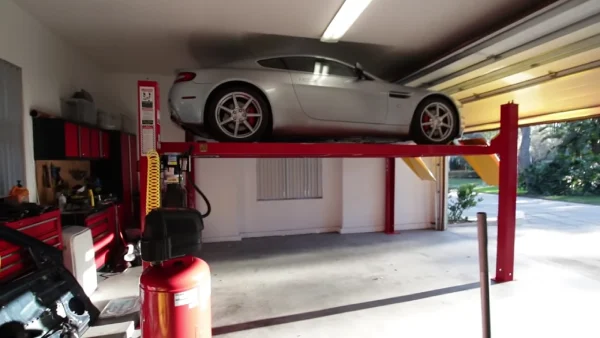
Can a Car lift fit in a 10-foot ceiling?
With their low profile design, they can easily be installed in spaces with lower ceilings, such as those found in residential or commercial garages and even auto repair shops with limited vertical clearance.
The minimum required height for the installation is about 8-10 feet, and most low-rise lifts will fit comfortably within this height range.
Can I Put a Car Lift in a Normal Garage?
Some lifts have adjustable arms that accommodate longer vehicles, while others come with multiple tiers so you can work on two or more cars simultaneously.
Before purchasing your lift, it’s essential to measure the area where it will be installed and ensure there is enough room for it before making your purchase.
How Thick Should Concrete be in a Garage to Install a Car Lift?
To ensure proper weight distribution when lifting heavy vehicles or equipment, it is important that all mounting holes drilled into the concrete are aligned properly and that no weak points exist along the base plates or foundation walls.
Also, additional reinforcement may be necessary if your garage floor has an uneven surface due to settling or other circumstances which could cause instability during operation.
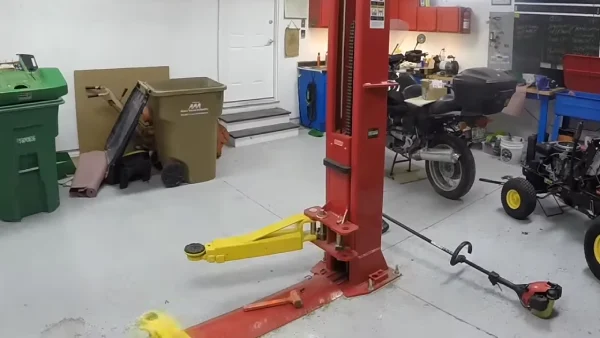
Where Should a 2-Post Car Lift be in a Garage?
The best placement options are typically along walls or in the center of large open spaces, ensuring that the lift has adequate support on all four corners.
What Should I Never Do With a Car Lift in the Garage?
Some things you should avoid with a car lift in your car garage include never using it as an overhead storage unit, never touching any exposed wiring or connections while underneath or near it, and never letting anyone stand directly underneath.
At the same time, it is being operated, never lowering a vehicle onto the support stand without taking proper measures to secure it first.
Can You Bump Out a Garage to Store a Lifted Truck?
It is possible to bump out a garage to create more storage space for a lifted truck. This can be accomplished by increasing the width and depth of the garage walls and floors.
Your newly expanded garage may also need special supports, like steel beams or bracing, depending on the size and weight of your truck.
While this can be a costlier option than simply buying a bigger pre-built garage. Bumping out your existing structure may be more convenient if you don’t want to move locations or deal with major construction projects.
Unlock Maximum Garage Potential by Installing A Car Lift In Your Garage
Adding a car lift in your vehicle garage can be a daunting task. You have to consider safety measurements, the size of the lift, and other things. But the most important thing is to ensure that your ceilings are tall enough and that there is enough space around the car lift for safe operation.
Furthermore, it’s essential to consider where the best location for the car lift would be so that you can use it easily. Once all these factors have been considered, any homeowner should feel confident about investing in their car lift.
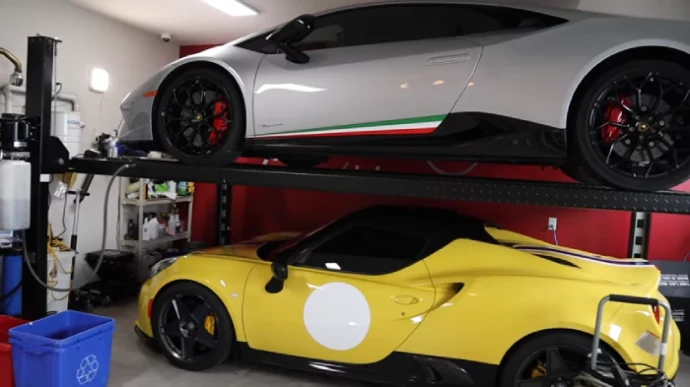
It’s nice that you mentioned how installing a car lift isn’t as simple as just buying one. I entered my friend’s garage yesterday and I noticed that he has a car lift. Car hoists definitely don’t look simple, but thankfully there are vehicle hoist servicing companies now.
My pleasure. 🙂